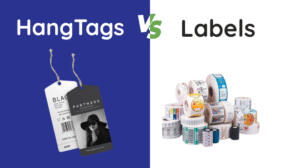Receipt paper serves as the backbone of transaction documentation in businesses worldwide, including retail outlets, supermarkets, restaurants, banks, logistics companies, and healthcare facilities. Selecting the correct type of receipt paper directly impacts point-of-sale efficiency, print clarity, archival durability, and customer satisfaction.
The most commonly used types are thermal paper, NCR (No Carbon Required) paper, and bond paper, each engineered for specific operational needs.Thermal paper provides fast printing without ink,NCR formscreates multiple copies effortlessly, and bond paper offers durability for archival purposes.
In this article, you’ll discover what receipt paper is, the differences between these main types, and how businesses choose the right solution for their printing needs.
Key Takeaways
Receipt paper comes in three main types—thermal, NCR (No Carbon Required), and bond paper—each designed for specific business needs, from fast, high-volume printing to multi-copy documentation and long-term archival records.
NCR paper enables clean, instant duplicates without carbon sheets, supporting multi-part forms for industries like logistics, banking, and retail, while thermal paper prioritizes speed and bond paper ensures durability.
Choosing the right receipt paper depends on transaction volume, printer compatibility, durability, cost, branding needs, and environmental considerations to optimize workflow and maintain professional documentation.
What Are the Types of Receipt Papers?
There are three main types of receipt paper used by businesses today are thermal paper, bond paper, and NCR (carbonless) paper.
Thermal Paper
Thermal paper is a heat-sensitive paper used in receipt printing, where the printed image appears when exposed to a thermal print head.
Uses:Thermal paper is widely used in POS systems, cash registers, ATMs, supermarkets, restaurants, and ticketing machines. Businesses rely on thermal paper for fast, high-volume transaction printing.
Mechanism:Thermal paper contains aspecial coating of heat-sensitive chemicalsthat react to thermal printer heads. When the printer applies heat, the coating changes color to produce text or images.
Advantages:
- Fast and efficient printing without ink or ribbons.
- High clarity and legibilityfor receipts and tickets.
- Reduces maintenance costs as no ink cartridges are required.
- Commonly available in standard widths (2¼”, 3¼”, 4”) compatible with most POS printers.
Disadvantages:
- Sensitive to heat, sunlight, and friction, which can fade receipts.
- Not suitable for long-term archival storage as the printed content can degrade.
- Some thermal papers contain BPA chemicals, which may raise environmental concerns.
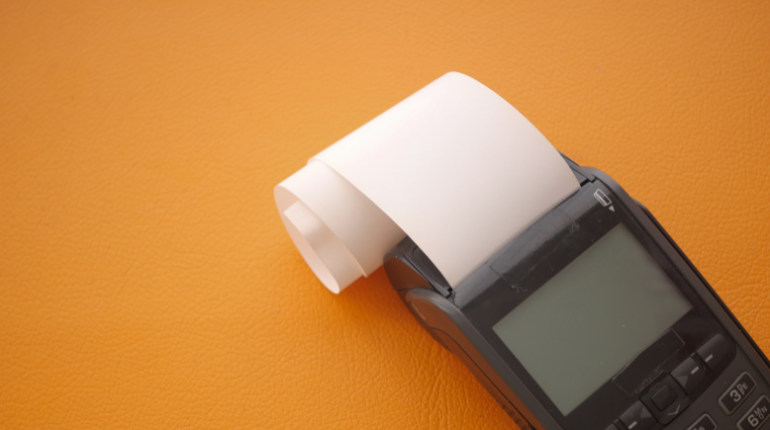
NCR (No Carbon Required) Paper
NCR paperis a multi-copy paper that produces duplicates without carbon sheets, commonly called carbonless copy paper.
Uses:NCR paper is used in delivery receipts, invoices, purchase orders, banking forms, and logistics documentation. Businesses adopt NCR paper where multiple copies are required simultaneously.
Mechanism:NCR paper has a micro-encapsulated dye coating on the back of the top sheet and a clay coating on the front of the bottom sheet. When pressure is applied by writing or printing, the capsules burst and transfer ink to the sheet below, creating an exact duplicate.

Advantages:
- Produces clean, precise duplicates without messy carbon sheets.
- Reduces time spent on manual copying.
- Supports multi-part forms, typically 2-5 layers.
- Environmentally friendlier than traditional carbon paper.
Disadvantages:
- More expensive than standard single-sheet paper.
- Sensitive to humidity; moisture can affect print quality.
- Not compatible with thermal printers, requires impact printing.
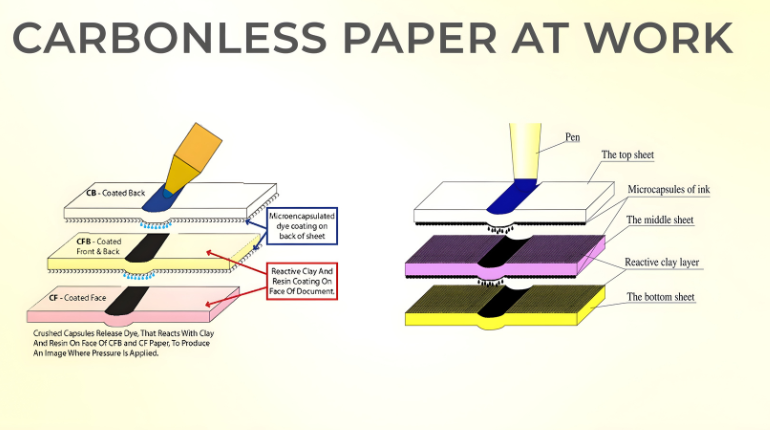
Bond Paper
Bond paper is a high-quality, durable paper used for official receipts, invoices, and archival documentation.
Uses:Bond paper is commonly used in banks, accounting offices, government institutions, and corporate invoicing. Businesses rely on bond paper for long-term storage and professional documentation.
Mechanism:Bond paper uses standard inkjet or laser printing technology, with strong fibers that provide durability and resistance to tearing or smudging.
Advantages:
- Durable and archival-quality, lasting years without degradation.
- Compatible withinkjet, laser, and impact printers.
- Provides aprofessional appearancefor official documents.
- Supportsmulti-format printingfor invoices, receipts, and statements.
Disadvantages:
- Higher cost per sheet compared to thermal or NCR paper.
- Slower printing in high-volume POS environments.
- Not suitable for heat-sensitive or fast-print applications.
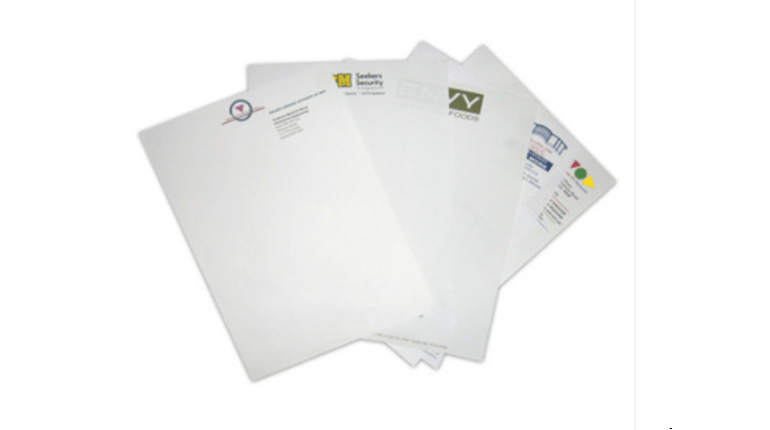
Final Conclusion
Below is the table showing the differences between the three paper types:
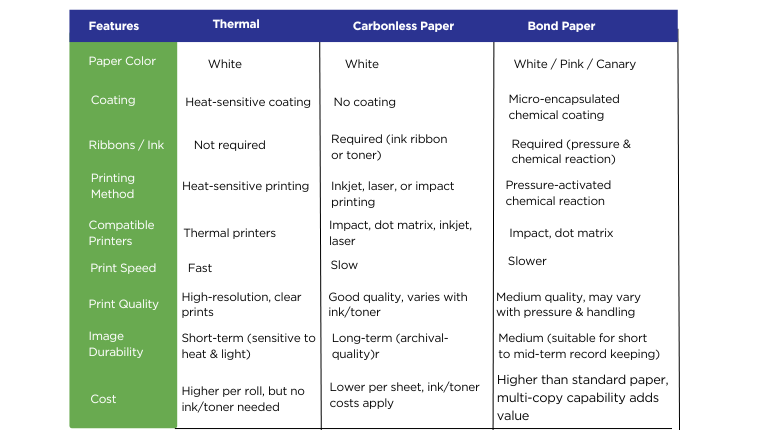
How to Choose the Right Receipt Paper?
To choose the right receipt paper, follow these steps:
Business Type & Transaction Needs:Thermal paper for high-volume businesses; NCR paper for multi-copy receipts; bond paper for durable, long-term records.
Durability & Environment:Thermal paper may fade under heat or sunlight; bond and NCR paper resist moisture, oils, and frequent handling.
Printer Compatibility:Thermal printers require thermal paper; impact/dot matrix printers work with NCR or bond paper; laser/inkjet printers suit bond or compatible NCR sheets.
Cost Considerations:Thermal paper reduces ink usage; bond and NCR paper may cost more upfront but save on reprints and support multiple copies.
Branding & Customization:Bond and NCR paper allow logos or messages; thermal rolls can be pre-printed for POS systems.
Archiving & Record-Keeping:Bond and NCR paper maintain long-term legibility; thermal paper suits short-term transactional records.
Environmental Considerations:Recyclable or eco-certified papers align with sustainability goals without compromising durability or print quality.
Conclusion
Choosing the right receipt paper is essential for smooth business operations, accurate record-keeping, and customer satisfaction. Thermal paper is ideal for high-volume, fast-print environments, offering quick, ink-free receipts.
NCR paper provides multi-copy functionality, perfect for transactions requiring duplicates. Bond paper delivers long-term durability and a professional appearance for archival records.
By considering transaction needs, printer compatibility, durability, cost, and branding, businesses can select the receipt paper that ensures efficiency, reliability, and a polished presentation. The right choice supports both operational workflow and long-term documentation goals.

